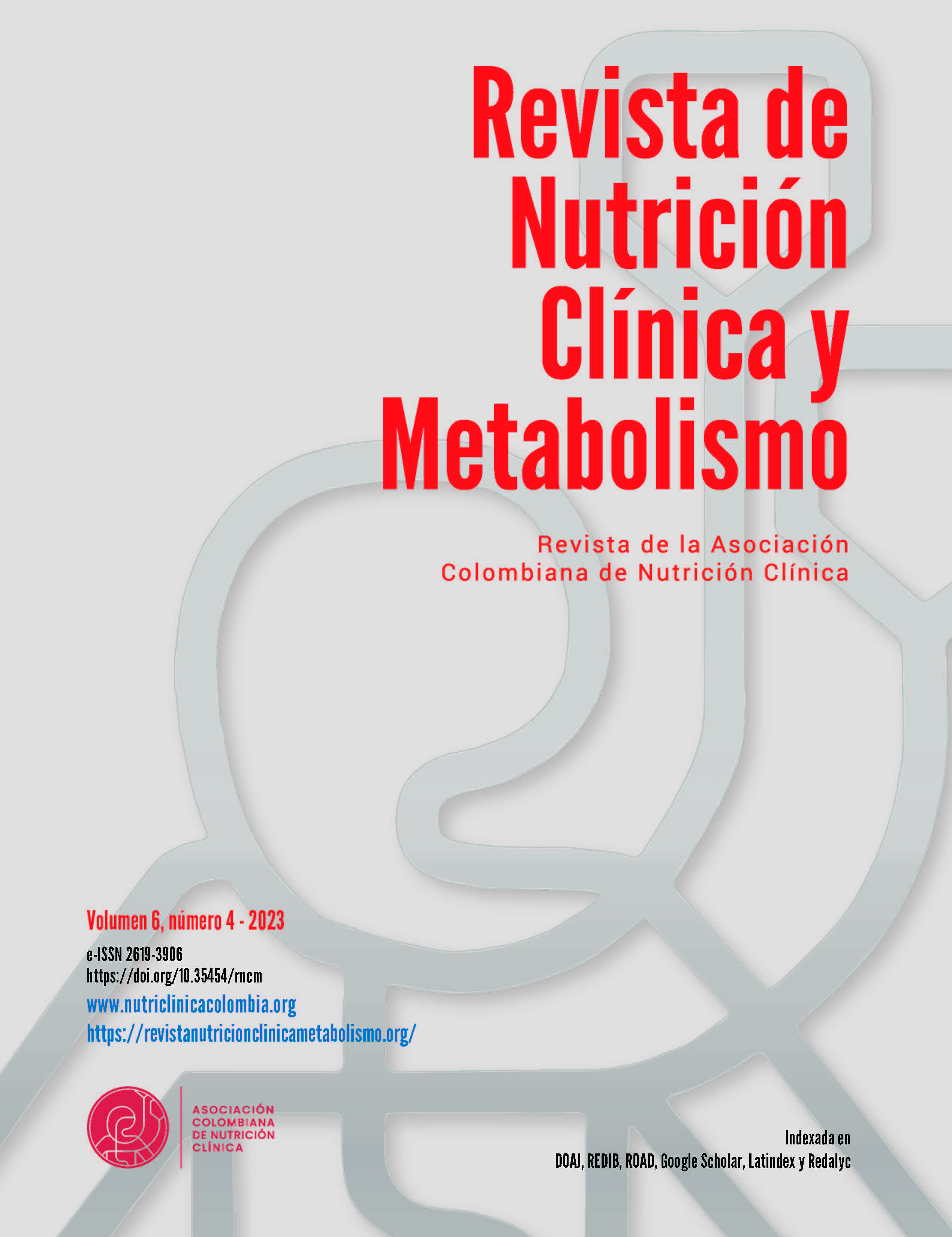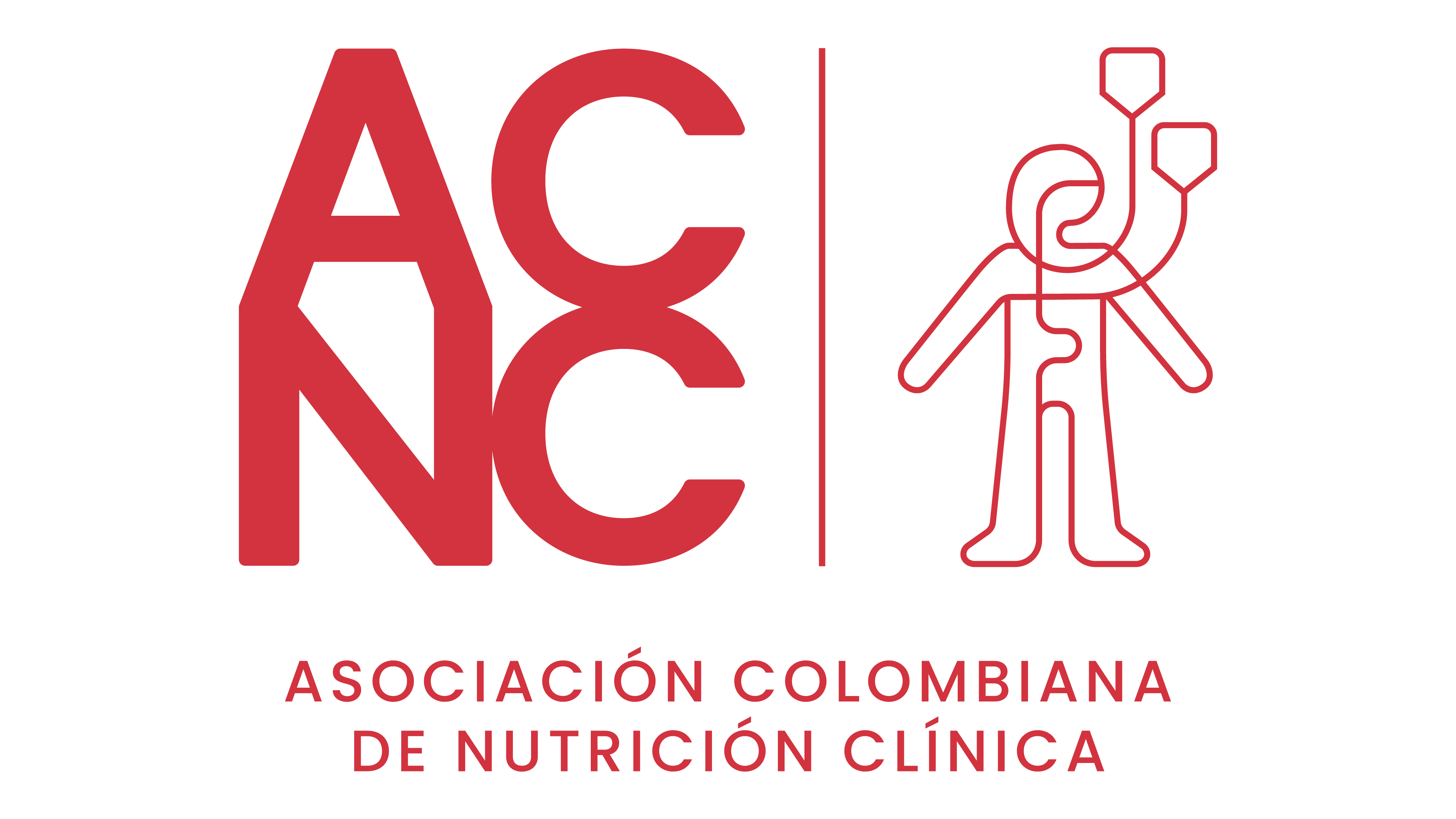Factores que afectan la ingesta de alimentos en adultos mayores hospitalizados: una revisión narrativa
DOI:
https://doi.org/10.35454/rncm.v6n4.563Palabras clave:
Anciano, Dieta, Ingesta de alimentos, Deficiencia de proteína, HospitalizaciónResumen
Introducción: la desnutrición se asocia con una mayor estancia hospitalaria, tasas de reingreso y riesgo de mortalidad, especialmente en adultos mayores.
Objetivo: identificar los factores que afectan la ingesta de alimentos en adultos mayores hospitalizados.
Justificación: promover nuevas estrategias en la terapia nutricional hospitalaria en pacientes adultos mayores a través de la identificación de los factores que afectan la ingesta de alimentos de acuerdo con la revisión del presente estudio.
Material y métodos: búsqueda sistemática de estudios publicados en las bases de datos de Springer Link, Medline y Scopus a través de la plataforma PubMed en mayo de 2022, con una temporalidad de 20 años. Se buscaron por términos controlados como: anciano, dieta, ingestión de alimentos, consumo de alimentos, deficiencia de proteína y hospitalización.
Resultados: se encontraron 4508 artículos en inglés, de los cuales se seleccionaron 28 para el análisis del texto completo debido al cumplimiento de criterios de selección.
Conclusiones: el estado nutricional en adultos mayores hospitalizados presenta afectaciones por factores como la enfermedad, la reducción de la actividad física, la fatiga, la depresión y la presencia de síntomas como náuseas y vómitos, la alteración en el proceso de masticación y deglución, y presentar un menor nivel educativo. Los factores dietéticos y de servicio que se relacionan con la baja ingesta son la temperatura de la dieta, la textura, el sabor y la apariencia, así como el mismo entorno hospitalario.
Descargas
Citas
Souza TT, Sturion CJ, Faintuch J. Is the skeleton still in the hospital closet? A review of hospital malnutrition emphasizing health economic aspects. Clinical Nutrition. 2015;34(6):1088-92. doi: 10.1016/j.clnu.2015.02.008
Stratton R, Green C, Elia M. Disease-related malnutrition: an evidence-based approach to treatment. Clinical Nutrition. 2003;22(6):585. doi: 10.1016/j.clnu.2003.08.003
Allepaerts S, Buckinx F, Bruyère O, Reginster JY, Paquot N, Gillain S. Clinical Impact of Nutritional Status and Energy Balance in Elderly Hospitalized Patients. J Nutr Health Aging. 2020;24(10):1073-79. doi: 10.1007/s12603-020-1527-9
Patel P, Phan E, Matarese L, Powell J. Another Skeleton in the Hospital Closet. Am J Gastroenterol. 2019;114:S1656. doi: 10.14309/01.ajg.0000601848.27444.71
Simzari K, Vahabzadeh D, Nouri Saeidlou S, Khoshbin S, Bektas Y. Food intake, plate waste and its association with malnutrition in hospitalized patients. Nutr Hosp. 2017;34(6):1376-81. doi: 10.20960/nh.1102
Schindler K, Themessl-Huber M, Hiesmayr M, Kosak S, Lainscak M, Laviano A, et al. To eat or not to eat? Indicators for reduced food intake in 91,245 patients hospitalized on nutritionDays 2006-2014 in 56 countries worldwide: A descriptive analysis. American Journal of Clinical Nutrition. 2016;104(5):1393-402. doi: 10.3945/ajcn.116.137125
Navarro DA, Boaz M, Krause I, Elis A, Chernov K, Giabra M, et al. Improved meal presentation increases food intake and decreases readmission rate in hospitalized patients. Clinical Nutrition. 2016;35(5):1153-8. doi: 10.1016/j.clnu.2015.09.012
Dijxhoorn DN, van den Berg MGA, Kievit W, Korzilius J, Drenth JPH, Wanten GJA. A novel in-hospital meal service improves protein and energy intake. Clinical Nutrition. 2018;37(6):2238-45. doi: 10.1016/j.clnu.2017.10.025
Kagansky N, Berner Y, Koren-Morag N, Perelman L, Knobler H, Levy S. Poor nutritional habits are predictors of poor outcome in very old hospitalized patients. Am J Clin Nutr. 2005;82(4):784-91; quiz 913-4. doi: 10.1093/ajcn/82.4.784
Cardenas D, Bermúdez C, Pérez A, Diaz G, Cortes LY, Contreras CP, et al. Nutritional risk is associated with an increase of in-hospital mortality and a reduction of being discharged home: Results of the 2009-2015 nutritionDay survey. Clin Nutr ESPEN. 2020;38:138-45. doi: 10.1016/j.clnesp.2020.05.014
Keller H, Allard J, Vesnaver E, Laporte M, Gramlich L, Bernier P, et al. Barriers to food intake in acute care hospitals: A report of the Canadian Malnutrition Task Force. J Hum Nutr Diet. 2015;28(6):546-57. doi: 10.1016/j.clnu.2003.08.003
Caldeira C, Vlysidis A, Fiore G, De Laurentiis V, Vignali G, Sala S. Sustainability of food waste biorefinery: A review on valorisation pathways, techno-economic constraints, and environmental assessment. Bioresour Technol. 2020;312:123575. doi: 10.1016/j.biortech.2020.123575
Maynard D da C, Vidigal MD, Farage P, Zandonadi RP, Nakano EY, Botelho RBA. Environmental, social and economic sustainability indicators applied to food services: A systematic review. Sustainability (Switzerland). 2020;12(5):1-19. doi: 10.3390/su12051804
Page MJ, McKenzie JE, Bossuyt PM, Boutron I, Hoffmann TC, Mulrow CD, et al. The PRISMA 2020 statement: an updated guideline for reporting systematic reviews. BMJ. 2021;372:n71. doi: 10.1136/bmj.n71
Wright C, Shankar B, Marshall S, Pearcy J, Somani A, Agarwal E. Prevalence of malnutrition risk and poor food intake in older adults in Indian hospitals: A prospective observational nutritionDay study with novel mapping of malnutrition risk to the Malnutrition Screening Tool. Nutrition and Dietetics. 2021;78(2):135-44. doi: 10.1111/1747-0080.12641
Sieske L, Janssen G, Babel N, Westhoff TH, Wirth R, Pourhassan M. Inflammation, Appetite and Food Intake in Older Hospitalized Patients. Nutrients. 2019;11(9):1986. doi: 10.3390/nu11091986
Young AM, Banks MD, Mudge AM. Improving nutrition care and intake for older hospital patients through system-level dietary and mealtime interventions. Clin Nutr ESPEN. 2018;24:140-47. doi: 10.1016/j.clnesp.2017.12.009
Eglseer D, Halfens RJG, Schols JMGA, Lohrmann C. Dysphagia in Hospitalized Older Patients: Associated Factors and Nutritional Interventions. J Nutr Health Aging. 2018;22(1):103-10. doi: 10.1007/s12603-017-0928-x
O’Shea E, Trawley S, Manning E, Barrett A, Browne V, Timmons S. Malnutrition in Hospitalised Older Adults: A Multicentre Observational Study of Prevalence, Associations and Outcomes. J Nutr Health Aging. 2017;21(7):830-36. doi: 10.1007/s12603-016-0831-x
Setiati S, Harimurti K, Dewiasty E, Istanti R, Mupangati YM, Ngestiningsih D, et al. Profile of food and nutrient intake among Indonesian elderly population and factors associated with energy intake: a multi-centre study. Acta Med Indones. 2013;45(4):265-74.
Söderström L, Thors Adolfsson E, Rosenblad A, Frid H, Saletti A, Bergkvist L. Mealtime habits and meal provision are associated with malnutrition among elderly patients admitted to hospital. Clin Nutr. 2013;32(2):281-8. doi: 10.1016/j.clnu.2012.07.013
Mudge AM, Ross LJ, Young AM, Isenring EA, Banks MD. Helping understand nutritional gaps in the elderly (HUNGER): a prospective study of patient factors associated with inadequate nutritional intake in older medical inpatients. Clin Nutr. 2011;30(3):320-5. doi: 10.1016/j.clnu.2010.12.007
Hirose K, Tran TP, Yamamoto S. Decreasing Salt in Hospital Meals Reduced Energy Intake in Elderly Japanese Inpatients. J Nutr Sci Vitaminol (Tokyo). 2021;67(2):105-10. doi: 10.3177/jnsv.67.105
Weijzen MEG, Kouw IWK, Geerlings P, Verdijk LB, van Loon LJC. During Hospitalization, Older Patients at Risk for Malnutrition Consume <0.65 Grams of Protein per Kilogram Body Weight per Day. Nutrition in Clinical Practice. 2020;35(4):655-63. doi: 10.1002/ncp.10542
Bell AF, Tapsell LC, Walton K, Batterham M. Unwrapping nutrition: Exploring the impact of hospital food and beverage packaging on plate waste/intake in older people. Appetite. 2020;144:104463. doi: 10.1016/j.appet.2019.104463
Tonkikh O, Shadmi E, Zisberg A. Food intake assessment in acutely ill older internal medicine patients. Geriatr Gerontol Int. 2019;19(9):890-95. doi: 10.1111/ggi.13744
Young AM, de Jersey SJ, Ellick J, Lewis CA, Banks M. Comparison of Patient Food Intake, Satisfaction and Meal Quality Between Two Meal Service Styles in a Geriatric Inpatient Unit. J Nutr Gerontol Geriatr. 2018;37(3-4):158-68. doi: 10.1080/21551197.2018.1483281
Beelen J, Vasse E, Janssen N, Janse A, de Roos NM, de Groot LCPGM. Protein-enriched familiar foods and drinks improve protein intake of hospitalized older patients: A randomized controlled trial. Clin Nutr. 2018;37(4):1186-92. doi: 10.1016/j.clnu.2017.05.010
Collins J, Porter J, Truby H, Huggins CE. A foodservice approach to enhance energy intake of elderly subacute patients: a pilot study to assess impact on patient outcomes and cost. Age Ageing. 2017;46(3):486-93. doi: 10.1093/ageing/afw238
McCray S, Maunder K, Krikowa R, MacKenzie-Shalders K. Room Service Improves Nutritional Intake and Increases Patient Satisfaction While Decreasing Food Waste and Cost. J Acad Nutr Diet. 2018;118(2):284-93. doi: 10.1016/j.jand.2017.05.014
Bell AF, Walton K, Chevis JS, Davies K, Manson C, Wypych A, et al. Accessing packaged food and beverages in hospital. Exploring experiences of patients and staff. Appetite. 2013;60(1):231-38. doi: 10.1016/j.appet.2012.10.013
Beermann T, Mortensen MN, Skadhauge LB, Høgsted RH, Rasmussen HH, Holst M. Protein and energy intake improved by breakfast intervention in hospital. Clin Nutr ESPEN. 2016;13:e23-e27. doi: 10.1016/j.clnesp.2016.02.097
Bell AF, Walton KL, Tapsell LC. Easy to open? Exploring the ‘openability’ of hospital food and beverage packaging by older adults. Appetite. 2016;98:125-32. doi: 10.1016/j.appet.2015.12.004
Roberts HC, Pilgrim AL, Jameson KA, Cooper C, Sayer AA, Robinson S. The Impact of Trained Volunteer Mealtime Assistants on the Dietary Intake of Older Female In-Patients: The Southampton Mealtime Assistance Study. J Nutr Health Aging. 2017;21(3):320-28. doi: 10.1007/s12603-016-0791-1
Orlandoni P, Jukic Peladic N, Cola C, Venturini C, Costantini A, Giorgini N, et al. Hospital acquired malnutrition in orally fed geriatric patients: what’s the role of a hospital dietetics and food service?. Progr Nutr. 2018;20(2-S):225-31. doi: 10.23751/pn.v20i2-S.5780
Mavrommatis Y, Moynihan PJ, Gosney MA, Methven L. Hospital catering systems and their impact on the sensorial profile of foods provided to older patients in the UK. Appetite. 2011;57(1):14-20. doi: 10.1016/j.appet.2011.03.010
Bannerman E, Cantwell L, Gaff L, Conroy A, Davidson I, Jones J. Dietary intakes in geriatric orthopaedic rehabilitation patients: Need to look at food consumption not just provision. Clin Nutr. 2016;35(4):892-9. doi: 10.1016/j.clnu.2015.06.001
Hope K, Ferguson M, Reidlinger DP, Agarwal E. “I don’t eat when I’m sick”: Older people’s food and mealtime experiences in hospital. Maturitas. 2017;97:6-13. doi: 10.1016/j.maturitas.2016.12.001
Markovski K, Nenov A, Ottaway A, Skinner E. Does eating environment have an impact on the protein and energy intake in the hospitalised elderly? Nutr Diet. 2017;74(3):224-28. doi: 10.1111/1747-0080.12314
Hartwell HJ, Shepherd PA, Edwards JSA. Effects of a hospital ward eating environment on patients’ mealtime experience: A pilot study. Nutrition and Dietetics. 2013;70(4):332-8. doi: 10.1111/1747-0080.12042
Sánchez Zaplana I, Maestre E. Alimentación y envejecimiento. Revista Rol de Enfermería 2013;36(6):400-7.
Ariza Galindo CJ, Rojas Aguilar DM. Disfagia en el adulto mayor. Universitas Medica. 2020;61(4). doi: 10.11144/Javeriana.umed61-4.disf
Spence C. On the psychological impact of food colour. Flavour. 2015;4(1):1-16. doi: 10.1186/s13411-015-0031-3
Eddy TP. Hospital food. Spence Flavour. 1964;18(2):49-55. doi: 10.3109/09637486409142693
Norris JA, Dahl W. Shopping for Health: Herbs and Spices. Edis. 2013:1-4. doi: 10.32473/edis-fs225-2013
Publicado
Cómo citar
Número
Sección
Licencia
Derechos de autor 2023 Valentina García Campos, Jhon Jairo Bejarano-Roncancio, Carolina Pinzón Ospina , Jorge Medina-Parra, Yeny Marjorie Cuéllar-Fernández, Samuel Durán-Agüero, Ricardo Alfonso Merchán Chaverra

Esta obra está bajo una licencia internacional Creative Commons Atribución-NoComercial-CompartirIgual 4.0.




















